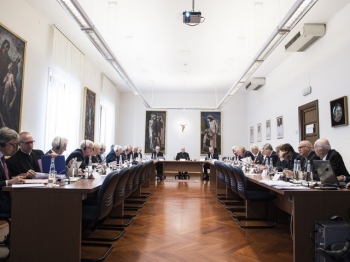The Grand Magisterium Spring 2017 Meeting

The members of the Grand Magisterium met on May 3 and 4 in Rome, gathered around Cardinal Edwin O’Brien, Grand Master, and in the presence of the Apostolic Administrator of the Latin Patriarchate of Jerusalem, Msgr. Pierbattista Pizzaballa.
This meeting, a time of prayer and work, gave the Grand Master the opportunity to thank the Governor General Agostino Borromeo, whose mandate expires at the end of June, and officially welcome his successor, Ambassador Leonardo Visconti di Modrone (already a member of the Grand Magisterium), whose term commences on June 29, 2017.
The participants in the meeting, moved by the announcement, stood for a long ovation in honor of Professor Borromeo at the end of the speech in which the Cardinal praised his qualities of integrity and faith, asking him to continue to make his experience available to the Grand Magisterium, especially in view of the next world assembly of the Order’s leaders, the Consulta, which is held every five years.
The Spring meeting started with the summary presentation of the budget of the previous year, which had the outstanding result of 16.3 million: this demonstrates the unrivaled generosity of members of the Order, unprecedented in the history of the Institution, after three years of steady growth of donations sent by the Lieutenancies to the Holy Land.
The enthusiasm and dynamism of Knights and Ladies throughout the world have undoubtedly strengthened, on the one hand, thanks to the pastoral activity of the Grand Master who responds positively to the invitations from the Lieutenancies but also because of the urgent needs of the Church in Jerusalem, as expressed by Msgr. Pizzaballa. The Apostolic Administrator outlined the situation in the Patriarchate territories, ranging from Jordan to Cyprus, passing through Palestine and Israel, underscoring the importance of the ecumenical approach experienced at the inauguration of the renovated sanctuary of the Holy Sepulchre. The second phase of this restoration project will strengthen the links between the Christian Churches, particularly the Catholic and Orthodox Churches.
Msgr. Pizzaballa, addressing several other topical issues, spoke in positive terms about the ongoing meetings to bring about the signing of a bilateral agreement allowing Israel and the Holy See to consolidate their relations, especially with regard to the status quo for Christian Holy Sites. He also shared his priority concern for the Christian identity of Jerusalem. In fact, Christians count for little more than a few thousand, including just 5,000 Catholic faithful in the Holy City. Regarding the internal organization of the Patriarchate, the Apostolic Administrator will make some important decisions at the end of June, based on his discussions with the priests of his diocese and the results of a financial audit conducted by an external advisory firm.
Father Imad Twal, Head of the Patriarchate’s Administrative and Accounting Services, subsequently presented the budget of the Patriarchal Diocese, insisting in particular on expenditure on refugees for whom the Catholic Church creates jobs, for example in the manufacture of hand-made Rosaries sold to pilgrims (aid to refugees through parishes amounts to $ 550,000). Overall, in 2016, institutional expenses as well as those for the seminary showed a surplus that partially compensates for the large overall deficit, valued at $ 5 million without counting the debts of the University of Madaba. A five-year plan, led by a commission appointed by Msgr. Pizzaballa, should soon favor school management, which is the essential and strategic work of the Church in the Holy Land, but which is still suffering from a lack of coordination.
The President of the Holy Land Commission, Thomas McKiernan, intervened to present the current status of the Grand Magisterum’s projects for 2017: the economic support for teachers’ wages, as has been the case for some years (more than $ 500,000), the construction of Jubeiha church (about one million dollars) and work on the Naour School (about $ 200,000).
The accounts of the Grand Magisterium were also on the agenda. Engineer Pier Carlo Visconti and Professor Pierre Blanchard expressed their satisfaction with the result achieved in 2016, more than 17 million also accounting for bank interests and income from property rental (four million more than in the previous year) while spending is declining and represented 7,64% of the budget. This all lends to a more effective aid to the Holy Land which is immersed in the effects of the Middle East crisis.
Chancellor Alfredo Bastianelli then took the floor to outline the stability in the Order’s statistics based on the currently available data, with about 15,000 Knights, 9,000 Dames and 4,000 ecclesiastics, divided among all five continents, but half in America.
The Chancellor also shared his will to create a graphic code at an international level to coordinate the universal image of the Order in a unified way. Communication activities, which Bastianelli also supervises, are in development thanks to the new website in five languages, as well as to the annual magazine and the quarterly bulletin (Newsletter), which have now been named Jerusalem Cross. A spiritual booklet produced by the Grand Magisterium Communication Office in coordination with Order’s Master of Ceremonies, Msgr. Fortunato Frezza, this year will help members of the Order to experience an hour of adoration on the Via Dolorosa for the Patriarchate’s intentions and peace in the Holy Land. T
he session concluded with some general news from Australia, Brazil and the Scandinavian countries and a discussion on the forthcoming Consulta, the assembly of those responsible for the Order that will be held in Rome in November 2018.
F.V.
(May 15, 2017)



